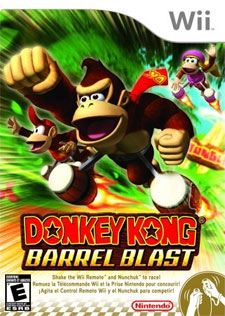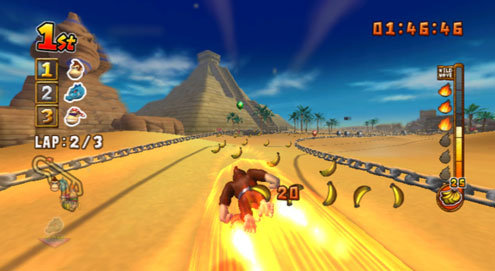 If it has achieved anything, the recently released Donkey Kong: Barrel Blast has proven Nintendo-produced Wii software is certainly not immune from negative criticism.
If it has achieved anything, the recently released Donkey Kong: Barrel Blast has proven Nintendo-produced Wii software is certainly not immune from negative criticism.
Dave Rudden of GamePro called Donkey Kong’s latest outing “offensive to all senses” and warned its “rancid nature…is likely to give you acid reflux.” IGN’s Mark Bozon bluntly called it a “waste of a game,” and Alex Navarro of GameSpot claimed it is nothing more than a “fifth-rate Mario Kart clone” with “frustrating AI and (a) total lack of personality.”
To say this game has received atrocious reviews would be an understatement. But while most critics have accurately honed in on the problems crippling Barrel Blast, they have been unnecessarily harsh with their criticisms. Despite the abundance of areas in which Barrel Blast whole-heartedly disappoints, there are some enjoyable qualities to be found within the game.
Not many, but some.
Donkey Kong: Barrel Blast is essentially a kart-racer without the karts. Donkey Kong and his pals blast through the jungle on rocket-barrel devices identical in appearance to the GameCube bongo controllers for which the game was originally planned. In the move to Wii development, however, bongo-pounding as a means of control was scrapped in favor of Wiimote waggling.
Players guide Donkey Kong characters by shaking the Wiimote and nunchuk. Players must drum them both simultaneously to reach “max speed,” at which point the racer will move forward automatically. In this regard, Barrel Blast is basically on rails; once max speed is reached, players need only steer their character through the course, which is done by shaking the nunchuk to move left and the Wiimote to move right. Players can also jump by flipping both controllers upward simultaneously. As gimmicky as it sounds – and it certainly is – it is a generally precise and unquestionably fun control scheme.
In a move sure to frustrate owners of the bongo controllers, Nintendo chose not to include bongo-support for Barrel Blast. There is no mistake about it; there should have been an option for their use, period.
From a gameplay standpoint, Barrel Blast is fairly unique. Unlike Mario Kart, the objective in Barrel Blast is not to avoid obstacles, but to crash through them. Players must collect as many bananas as they can as they steer through the courses; for every 50 bananas collected, the player is rewarded with a speed burst called a “wild move.” These are used by pulling back on the analog stick to charge your racer and letting go to quickly blast forward. From a control standpoint, it actually feels quite satisfying. But these bursts are generally useless on their own, and they are only effective when combinations are strung together. This is achieved by smashing through barrels cleverly scattered throughout the course, which is easily the best aspect of the game. This also invites some interesting strategy: collect bananas, charge up a burst and quickly string together barrel-smashes to continue the speed burst.
Sans “wild moves,” however, the game is incredibly slow. Even at “max speed,” the racers feel as though they are crawling through the course. If not for the speed burst elements and the challenge of stringing together combos, the gameplay would be a disaster. In fact, the game doesn’t fully capitalize on its strengths until it is played in Expert mode. This is not because of an increased difficulty level, but because it makes Barrel Blast much faster and places more barrels on the courses. Rookie mode is ultimately a slow-moving snooze-fest, and although Pro mode ramps things up, none of the game’s modes come close to reaching their potential unless played in Expert difficulty.
The problem is that Expert mode is initially locked. Players will have to endure through the lesser difficulty levels to unlock it, which is something many gamers simply may not feel is worth the trouble.

Any good racer should offer a robust selection of modes, and in that regard, Barrel Blast is quite impressive. The Jungle Grand Prix offers four cups – Topaz, Sapphire, Diamond and Platinum – to work through, and in addition, players can choose to participate in a Single Race on any of the courses. Both modes offer up to four-player split-screen multiplayer. There is also a classic Time Trial mode, as well as an unlimited Free Run mode in which players can race through any course without time constraints to learn the nuances of each track. In addition, players can learn the basics of the controls by completing Cranky’s Flight School, or master the control mechanics in Candy’s Challenges, which offers a decent selection of increasingly difficult missions.
As great as this may sound, there are several caveats preventing Barrel Blast from being as good as it should be. Though there are four different cups with 16 total tracks, there are actually only seven unique courses. The other nine are merely “remixes” of the original seven; for example, the DK Jungle course in the Topaz Cup is later recycled in the Sapphire Cup as DK Jungle Falls, with minor changes only in difficulty and obstacle placement.
The game’s strength lies in its ability to attract multiplayer sessions, and to its credit, it is almost impossible to not have fun with Barrel Blast’s multiplayer modes. But the lack of online support is a glaring omission. In a launch title like Excite Truck, the choice to omit online races and leaderboards was at least remotely understandable. But for Barrel Blast to release almost a year later with no WiFi or WiiConnect24 support is simply inexcusable.
In terms of its presentation, Barrel Blast is a mixed bag. The game supports 480p and true 16:9 widescreen, and there are also some very nice visual effects scattered throughout. While the game looks great in motion, however, it suffers from occasionally blurry textures and a generally “GameCubey” look in its character models and environments. Given that the game was originally developed for GameCube, this is understandable. But considering the impressive visuals beginning to appear in Wii games, it is worth noting that Barrel Blast should look much better than it does on Nintendo’s hardware.
Chief among the game’s weaknesses in presentation, however, is the fact that it often feels forced and spread thin. When Barrel Blast utilizes familiar locales, elements, characters and remixed music from the SNES classic Donkey Kong Country, the racing is made infinitely more appealing. It is easier to embrace the concept when confronted with familiar, long-cherished Donkey Kong Country elements, and when they are used, the game feels much more enjoyable. But strange item selection, seemingly non-sensical tracks – why is Donkey Kong racing through space or a temple in the sky? – and forgettable characters suggest the Donkey Kong franchise simply isn’t robust enough to support the types of spin-offs that the Mario franchise is capable of.
This is most painfully evident in the character selection. Though the selection is adequate in number – there are 16 racers in all – does anyone actually want to race as Kalypso the Kremling or the horribly designed Lanky Kong? One of the reasons Mario Kart has succeeded as a franchise is because each of the racers on the roster is a beloved Nintendo icon. But with the exception of Donkey Kong, Diddy, Dixie, Cranky and rival King K. Rool, there are simply no memorable characters to choose from in Barrel Blast.
And since when is Tiny Kong not tiny? Her taller, reworked frame in Barrel Blast makes her look absolutely bizarre.
If there is a single non-human personality in the Nintendo universe capable of breaking through to the masses on Wii, it is unequivocally Donkey Kong. But he is at his best when kidnapping damsels and platforming through the jungle in pursuit of bananas. Otherwise, the lovable apes falters.
It’s not difficult to remember the days when a new Donkey Kong release actually meant something. Here’s hoping Nintendo remembers it, too. Donkey Kong: Barrel Blast gets two stars out of four.

